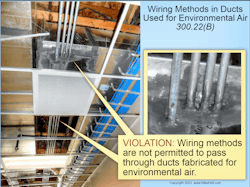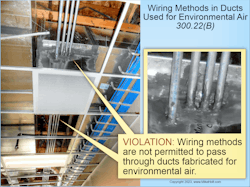Courtesy of www.MikeHolt.com
Q. What are the NEC requirements related to the installation of wiring within ducts for dust, vapor, or environmental air?
See answer below.
A. The requirements of Sec. 300.22 apply to the installation and uses of electrical wiring and equipment in ducts used for dust or vapor removal, ducts specifically fabricated for environmental air.
(A) Ducts Used for Dust or Vapor. Wiring methods are not permitted to be installed in ducts that transport dust or flammable vapors.
(B) Ducts Fabricated for Environmental Air. Equipment and wiring methods are only permitted within a duct fabricated to transport environmental air if the equipment is necessary for direct action upon or sensing the contained air. (Figure)
Type MC cable without an overall nonmetallic covering and metal raceways can be installed in ducts fabricated to transport environmental air. Flexible metal conduits in lengths not exceeding 4 ft can be used to connect physically adjustable equipment and devices within the fabricated duct.
Exception: Wiring methods and cabling systems, listed for use in plenum spaces, can be installed in ducts specifically fabricated for environmental air-handling purposes under both of the following conditions:
(1) The wiring methods or cabling systems are necessary to connect to equipment or devices associated with the direct action upon or sensing of the contained air, and
(2) The total length of such wiring methods or cabling systems does not exceed 4 ft.
These materials are provided to us by Mike Holt Enterprises in Leesburg, Fla. To view Code training materials offered by this company, visit www.mikeholt.com/code.
About the Author

Mike Holt
Mike Holt is the owner of Mike Holt Enterprises (www.MikeHolt.com), one of the largest electrical publishers in the United States. He earned a master's degree in the Business Administration Program (MBA) from the University of Miami. He earned his reputation as a National Electrical Code (NEC) expert by working his way up through the electrical trade. Formally a construction editor for two different trade publications, Mike started his career as an apprentice electrician and eventually became a master electrician, an electrical inspector, a contractor, and an educator. Mike has taught more than 1,000 classes on 30 different electrical-related subjects — ranging from alarm installations to exam preparation and voltage drop calculations. He continues to produce seminars, videos, books, and online training for the trade as well as contribute monthly Code content to EC&M magazine.


